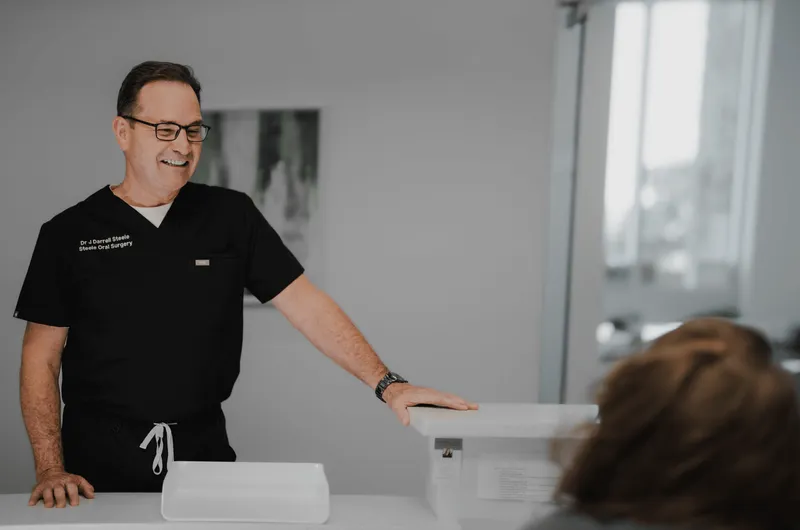Sedation vs. General Anesthesia for Full‑Arch Implants: What You’ll Really Feel

Contents
Quick Take
For long, complex full‑arch procedures, comfort and control matter most. IV sedation can relax you—but you may still feel pressure and injections. Many surgeons favor general anesthesia (GA) with a dedicated anesthesiologist so the surgeon can focus entirely on the work and deliver a more controlled, efficient surgery.
“Every surgeon you ever talk to… will definitely choose a patient that’s completely under general anesthesia, because you get better control of everything.” — Dr. Perry Brooks
Definitions in Plain English
- Minimal/Moderate (“conscious”) IV sedation: You’re drowsy and relaxed. You can respond to questions and breathe on your own. You may still feel pressure or injections.
- Deep sedation: You’re difficult to arouse and might need help keeping your airway open.
- General anesthesia (GA): You’re fully asleep and unaware. An anesthesia professional manages your airway, breathing, and vital signs under established guidelines.
“IV sedation is almost like having a couple glasses of wine… you’re still able to feel things and you feel pressure and… getting anesthetized with local anesthetic. You’ll feel that if you’re under conscious sedation.” — Dr. Perry Brooks
What Patients Actually Feel
- IV Sedation: Most people describe it as relaxed and drowsy. You may still notice pressure, tugging, water spray, and brief stinging from numbing injections. You can usually follow simple instructions.
- General Anesthesia: You are fully asleep and have no awareness of injections, drilling, or pressure. Your airway and medications are managed by a dedicated anesthesia provider while the surgeon operates.
“The surgeon’s gonna do a lot better surgery, guaranteed… you’re gonna irrigate more, you’re gonna do better surgery, you’re gonna get better results, long‑term and short‑term.” — Dr. Perry Brooks
Why Many Surgeons Prefer GA
Full‑arch cases are long and detail‑heavy. Many surgeons believe that general anesthesia improves focus, safety, and results—especially when an MD anesthesiologist handles airway management and monitoring.
“I used to do my own GA… it’s not as efficient; you have to pay attention to both sides and then you’re distracted when you’re doing surgery.” — Dr. Perry Brooks
The ideal setup includes a six-person team: circulator, two surgical assistants, anesthesiologist, prosthodontist, and oral surgeon.
Related Reading: Learn about some Smileloc Terms with our terms explained article , or explore more about Dr. Perry Brooks
Who It's For
- Patients choosing full‑arch or other multi‑site, time‑intensive procedures.
- Anxious patients who want zero awareness.
- People with complex medical histories needing controlled anesthesia.
What to Expect (Step by Step)
- Pre‑op health review: Be honest about medications and conditions.
- Anesthesia plan: Meet the anesthesiologist, review your plan, confirm allergies, fasting rules, and medication timing.
- Day of surgery: You’re fully asleep under GA. The surgeon and prosthodontist focus on surgery while your airway and vitals are managed. A technician prepares your temporary teeth.
- Waking up: You’ll feel groggy and need a ride home. Follow our care instructions closely.
“It’s never okay to lie under any circumstance when it comes to medical issues… If I don’t know ahead of time, I can’t give you the best options.” — Dr. Perry Brooks
Benefits & Risks
Benefits
- Total comfort and amnesia during surgery.
- Better surgical control and outcomes.
- Safety through constant monitoring by anesthesia professionals.
Risks
- Rare but possible airway or breathing complications.
- Some health conditions (like smoking or uncontrolled diabetes) may increase healing time or risks.
- You'll need a driver, fasting, and recovery time.
Recovery & Aftercare
- Hours 0–24: Rest, use gauze, and apply ice packs.
- Week 1: Swelling may peak on days 2–3. Stick to soft foods.
- Weeks 4–6: Implant stability may feel lower—don’t stress them.
- Month 3+: We’ll help you return to normal foods and routines.
Costs & Financing
General anesthesia adds cost due to the facility and medical staff involved. We offer clear pricing, phased treatment plans, and monthly financing at /financing.
Smileloc Difference
- Separate anesthesia and surgery providers—each expert focuses on their role.
- Pre-planned digital surgery to save time.
- In-house lab tech ensures natural-looking temporary teeth.
- Compassionate, judgment-free care.
Next Steps
Ready to choose the safest, most comfortable plan for your situation?
📞 Call +1 (737) 227-3037 or book your free consultation here